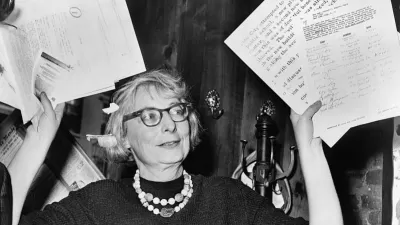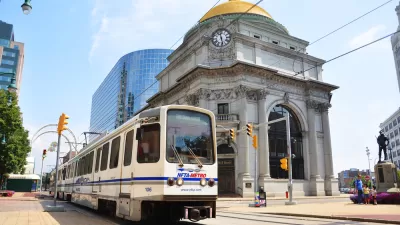Although it is sometimes difficult to recognize in day-to-day planning activities, our ultimate goal is to make the world better, that is, to help create paradise on earth. It’s a tough job, but somebody’s got to do it! There are two different and often conflicting concepts of how to create paradise. It is important that planners understand the differences between them.
Although it is sometimes difficult to recognize in day-to-day planning activities, our ultimate goal is to make the world better, that is, to help create paradise on earth. It's a tough job, but somebody's got to do it!
There are two different and often conflicting concepts of how to create paradise. It is important that planners understand the differences between them.
One concept considers paradise a commodity, a good that consumers purchase based on their ability to pay. For example, magazines often publish articles with titles such as "The Ten Best Places to Live" or "The Ten Best Places To Raise A Family," with the implication that consumers will find happiness simply by living there. Similarly, exotic resorts are promoted as paradise, with the implication that a visit will create a truly orgasmic vacation, and giant regional shopping centers are promoted as shoppers' paradise.
But not everything is a commodity. Many things of great value, such as love, friendship, and health, depend more on people's behavior than their expenditures. From this perspective, paradise is something we create at our current location through responsible and thoughtful effort. Paradise-as-place is reflected in people's efforts to improve their home and garden, befriend their neighbors, and enhance their community's built and natural environments.
These two different visions of paradise often conflict, particularly with regard to transport decisions. Paradise-as-commodity requires ever-increasing mobility so people can chase ever-better real estate and travel deals. Conversely, paradise-as-place often requires limiting mobility, particularly where excessive motorized travel threatens a community's social and environmental quality.
Planning is full of mutually-exclusive decisions that require choosing between enhanced mobility or quality of place. For example, widening a road to allow increased vehicle traffic speeds and volumes increases mobility (and therefore people's ability to live, work and shop in more distant locations) while despoiling the quality of the street environment. Similarly, large parking lots accommodate more vehicle trips to a destination, but degrade the local environment and create a barrier to walking.
Social and personal decisions also involve such tradeoffs. A highly mobile lifestyle allows people to visit more places, reducing people's social networks and emotional investment in any one community. Households located in multi-modal communities (where people rely significantly on walking, cycling and public transit) generally spend less on mobility and more on housing than if they locate in suburban or rural areas, which is economically beneficial since motor vehicles rapidly depreciate while housing investments tend to appreciate, as well as being socially and environmentally beneficial.
Put simply, paradise-as-commodity requires that "mobility trumps place" in planning decisions, while paradise-as-place requires that "place trumps mobility." Unfortunately, many current planning practices inherently favor mobility over place. For example, generous minimum parking requirements in zoning codes, dedicated road and parking facility funds that cannot be shifted to alternative community investments, and consolidation of public services into fewer, larger, more centralized facilities all favor mobility at the expense of existing communities, reflecting the assumption that paradise is a distant place to which people must travel, rather than an enhancement of their current location.
Fortunately, many new trends are returning more balance to mobility-versus-place tradeoffs. Efforts to redevelopment existing communities, apply new urbanism design practices, create streets that are attractive places to be rather than just corridors to travel through, and enhance walkability all reflect a shift toward place-over-mobility.
This is not to suggest that mobility is necessarily bad or that consumers should never travel to exotic locations for holidays. However, it is a warning that we should avoid the temptation to think that the grass is always greener somewhere else, or that increased mobility necessarily makes people happier. This is not a new issue; as Dorothy explained to the good witch Glinda about her adventures in the Land of Oz. "I learned that if I ever go looking for my heart's desire again, I won't look any further than my own backyard, because if it isn't there, I never really lost it in the first place."

Planetizen Federal Action Tracker
A weekly monitor of how Trump’s orders and actions are impacting planners and planning in America.

Maui's Vacation Rental Debate Turns Ugly
Verbal attacks, misinformation campaigns and fistfights plague a high-stakes debate to convert thousands of vacation rentals into long-term housing.

San Francisco Suspends Traffic Calming Amidst Record Deaths
Citing “a challenging fiscal landscape,” the city will cease the program on the heels of 42 traffic deaths, including 24 pedestrians.

Amtrak Rolls Out New Orleans to Alabama “Mardi Gras” Train
The new service will operate morning and evening departures between Mobile and New Orleans.

The Subversive Car-Free Guide to Trump's Great American Road Trip
Car-free ways to access Chicagoland’s best tourist attractions.

San Antonio and Austin are Fusing Into one Massive Megaregion
The region spanning the two central Texas cities is growing fast, posing challenges for local infrastructure and water supplies.
Urban Design for Planners 1: Software Tools
This six-course series explores essential urban design concepts using open source software and equips planners with the tools they need to participate fully in the urban design process.
Planning for Universal Design
Learn the tools for implementing Universal Design in planning regulations.
Heyer Gruel & Associates PA
JM Goldson LLC
Custer County Colorado
City of Camden Redevelopment Agency
City of Astoria
Transportation Research & Education Center (TREC) at Portland State University
Jefferson Parish Government
Camden Redevelopment Agency
City of Claremont






























